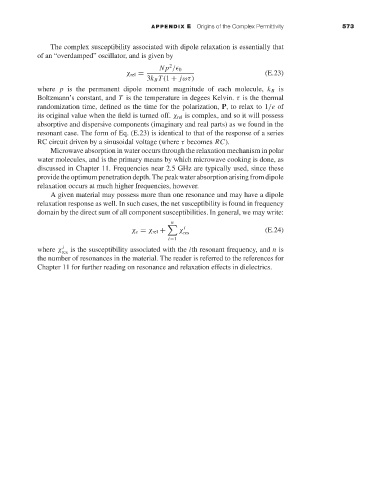Page 591 - Engineering Electromagnetics, 8th Edition
P. 591
APPENDIX E Origins of the Complex Permittivity 573
The complex susceptibility associated with dipole relaxation is essentially that
of an “overdamped” oscillator, and is given by
2
Np / 0
χ rel = (E.23)
3k B T (1 + jωτ)
where p is the permanent dipole moment magnitude of each molecule, k B is
Boltzmann’s constant, and T is the temperature in degees Kelvin. τ is the thermal
randomization time, defined as the time for the polarization, P,to relax to 1/e of
its original value when the field is turned off. χ rel is complex, and so it will possess
absorptive and dispersive components (imaginary and real parts) as we found in the
resonant case. The form of Eq. (E.23) is identical to that of the response of a series
RC circuit driven by a sinusoidal voltage (where τ becomes RC).
Microwave absorption in water occurs through the relaxation mechanism in polar
water molecules, and is the primary means by which microwave cooking is done, as
discussed in Chapter 11. Frequencies near 2.5 GHz are typically used, since these
provide the optimum penetration depth. The peak water absorption arising from dipole
relaxation occurs at much higher frequencies, however.
Agiven material may possess more than one resonance and may have a dipole
relaxation response as well. In such cases, the net susceptibility is found in frequency
domain by the direct sum of all component susceptibilities. In general, we may write:
n
i
χ e = χ rel + χ res (E.24)
i=1
where χ i res is the susceptibility associated with the ith resonant frequency, and n is
the number of resonances in the material. The reader is referred to the references for
Chapter 11 for further reading on resonance and relaxation effects in dielectrics.

